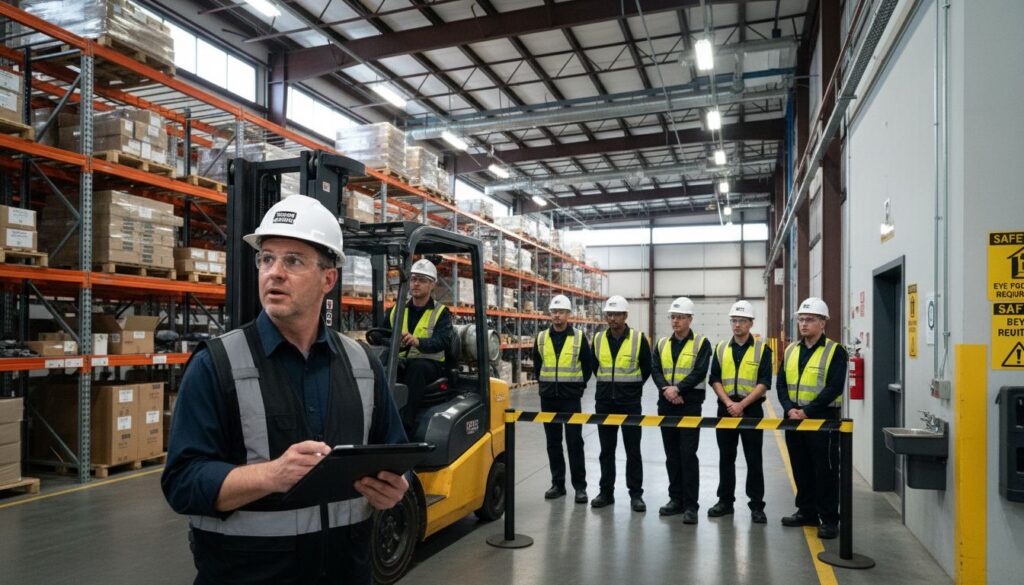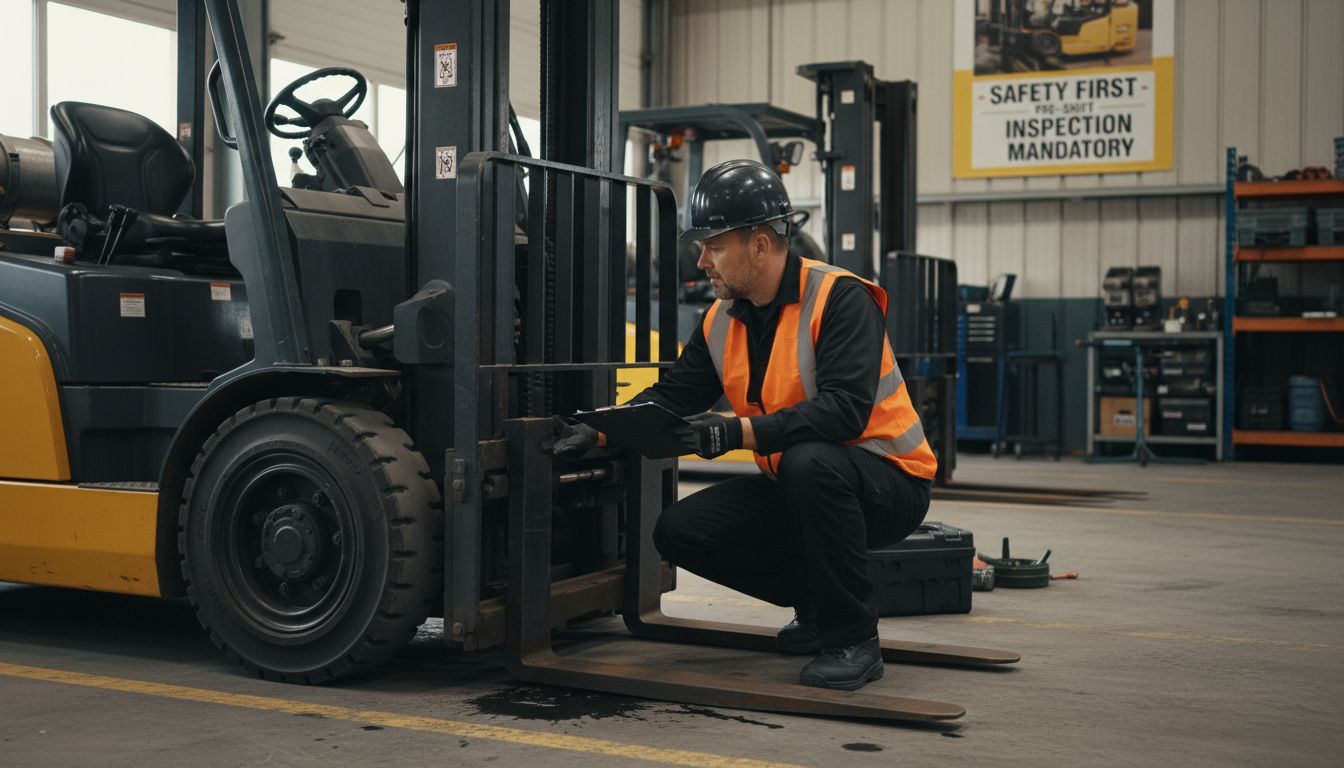
Every year, more than 34,000 serious injuries in american workplaces are linked to forklift accidents. Keeping these numbers down relies on strict training compliance, which shapes not only legal protection but daily safety for workers. When businesses understand and meet these standards, they protect employees, avoid costly legal issues, and ensure smooth operations. This article breaks down what every employer and operator needs to know about staying compliant and building a culture of safety in the american industrial sector.
| Point | Details |
|---|---|
| Forklift Training Compliance | Compliance with OSHA standards is essential for workplace safety and requires structured training programs covering theory, practical skills, and hazard evaluations. |
| Continuous Improvement | Training and certification should be viewed as ongoing processes, with regular recertification and updates to adapt to changing safety technologies. |
| Employer Responsibilities | Employers are legally required to provide Comprehensive OSHA-compliant training, maintain equipment, and enforce safety protocols to prevent accidents. |
| Common Compliance Mistakes | Organizations must avoid documentation errors, operational oversights, and procedural mishaps to maintain compliance and ensure safety in the workplace. |
Forklift training compliance standards represent the critical framework that ensures workplace safety and operational excellence in material handling environments. These comprehensive guidelines establish the minimum requirements for operators to legally and safely operate powered industrial trucks across various industrial settings. Understanding these standards is not just about meeting regulatory obligations – it’s about creating a culture of safety that protects workers and prevents potentially catastrophic workplace accidents.
The primary regulatory body governing forklift training standards is the Occupational Safety and Health Administration (OSHA), which mandates specific training protocols to minimize workplace risks. These standards require employers to provide structured training programs that cover theoretical knowledge, practical skills, and workplace-specific operational techniques. As outlined in OSHA Compliance: Navigating Forklift Certification Requirements, the training must encompass multiple critical components:
Comprehensive forklift training compliance goes beyond basic operational instructions. It involves a holistic approach that includes understanding equipment mechanics, recognizing potential workplace hazards, implementing proper safety protocols, and developing situational awareness. Operators must demonstrate proficiency in not just driving the equipment, but in assessing and mitigating potential risks in dynamic work environments. Certification programs must validate an operator’s ability to perform tasks safely, understand equipment limitations, and respond appropriately to unexpected challenges.
The consequences of inadequate training can be severe. Workplace accidents involving forklifts can result in significant injuries, fatalities, property damage, and substantial legal and financial repercussions for businesses. By adhering to rigorous OSHA compliance standards, organizations create safer workplaces, reduce accident risks, and demonstrate a commitment to employee well-being. Training is not a one-time event but a continuous process of education, evaluation, and improvement that adapts to evolving workplace technologies and safety requirements.
OSHA forklift certification requirements represent a comprehensive framework designed to ensure workplace safety and minimize potential accidents involving powered industrial trucks. These standards are not merely bureaucratic checklists but critical protocols that protect workers and create systematic approaches to equipment operation. Every employer must understand and implement these requirements to maintain a safe working environment and comply with federal safety regulations.
To achieve full OSHA compliance, organizations must follow a structured certification process that includes multiple critical components. As detailed in Forklift Training Program Guide for OSHA Certification Success, the certification process typically involves:
The certification requirements are rigorous and multifaceted. Operators must demonstrate not just technical proficiency, but also a deep understanding of safety protocols, equipment limitations, and potential workplace hazards. This includes understanding different forklift classifications, recognizing specific operational risks, and developing situational awareness. OSHA mandates that training must be specific to the type of equipment an operator will use, ensuring that theoretical knowledge translates directly into safe, practical application.
Recertification is a crucial aspect of maintaining OSHA compliance. Operators must be re-evaluated at least once every three years, or sooner if they are observed operating unsafely, are involved in an accident, or near-miss incident, or are assigned to a different type of truck. This continuous learning approach ensures that operators remain current with evolving safety standards, technological advancements, and best practices in material handling. By treating certification as an ongoing process rather than a one-time achievement, organizations demonstrate a commitment to worker safety and operational excellence.
Forklift and scissor lift training encompasses a diverse range of specialized programs designed to prepare operators for safe and efficient equipment operation across various industrial environments. As Tamkene highlights, comprehensive training covers multiple equipment types, each requiring unique skills and safety protocols. Understanding these variations is crucial for workplace safety and operational effectiveness.
The primary categories of forklift training include:
As outlined by 360training, scissor lift training focuses on aerial work platforms used in construction, maintenance, and industrial settings. These specialized programs address unique operational challenges, including:
Comprehensive training goes beyond basic operational skills. Operators must understand equipment-specific nuances, workplace-specific risks, and advanced safety protocols. Certification programs typically combine theoretical knowledge with practical hands-on experience, ensuring operators can confidently navigate complex work environments. The goal is not just compliance, but creating a culture of safety that protects workers and enhances operational efficiency across diverse industrial settings.
Achieving forklift certification is a structured process that requires careful preparation, comprehensive training, and demonstrated competency across multiple skill domains. Prospective operators must navigate a series of rigorous steps designed to ensure workplace safety and operational excellence. As outlined in How to Get OSHA Forklift Certification, the certification journey involves strategic progression through theoretical and practical requirements.
The certification process typically encompasses these essential steps:
Successful certification requires more than simply passing tests. Operators must demonstrate a holistic understanding of safety principles, equipment limitations, and workplace dynamics. The process is designed to create competent professionals who can navigate complex industrial environments with confidence and precision.
 Employers benefit from certified operators who minimize risks, improve operational efficiency, and contribute to a culture of workplace safety.
Employers benefit from certified operators who minimize risks, improve operational efficiency, and contribute to a culture of workplace safety.

Employer responsibilities in forklift safety extend far beyond simple training requirements, encompassing a comprehensive legal and ethical obligation to protect workers and maintain a safe operational environment. Legal liability represents a critical dimension of workplace management, where employers bear direct responsibility for ensuring proper training, equipment maintenance, and ongoing safety protocols.
Key employer responsibilities include:
Training Mandate
Provide comprehensive OSHA-compliant certification programs
Ensure all operators receive initial and recurring training
Maintain detailed training documentation
Verify operator competency through periodic assessments
Equipment Management
Conduct regular equipment inspections
Maintain forklifts in safe operational condition
Replace or repair damaged equipment promptly
Implement comprehensive maintenance tracking systems
Workplace Safety Protocols
Develop site-specific safety guidelines
Create clear operational procedures
Install appropriate safety signage
Establish emergency response mechanisms
Legal consequences for non-compliance can be severe. Employers may face significant financial penalties, potential criminal charges, and civil lawsuits if workplace accidents result from inadequate training or negligent safety practices. As outlined in Complete Guide to Forklift Certification, the financial and reputational risks of ignoring safety standards far outweigh the investment required for comprehensive training and equipment management.
Beyond legal requirements, creating a robust safety culture represents a strategic business approach. Proactive employers recognize that investing in comprehensive training, maintaining equipment, and prioritizing worker safety directly contributes to operational efficiency, reduces workplace incidents, and demonstrates corporate responsibility. The most successful organizations view safety not as a regulatory burden, but as a fundamental component of professional excellence and organizational integrity.
Forklift training compliance is a complex landscape where seemingly minor oversights can lead to significant safety risks and legal consequences. Organizations frequently encounter preventable errors that compromise workplace safety and expose themselves to potential regulatory penalties. Understanding these common mistakes is crucial for developing a proactive approach to forklift operator certification and safety management.
The most frequent compliance mistakes include:
Documentation and Training Errors
Operational and Equipment Compliance Issues
Procedural and Administrative Mistakes
As detailed in How Forklift Certification Works, addressing these compliance gaps requires a systematic and ongoing commitment to safety education. Successful organizations implement robust monitoring systems, maintain meticulous documentation, and foster a culture of continuous learning and improvement. By proactively identifying and addressing potential compliance weaknesses, businesses can significantly reduce workplace accidents, minimize legal risks, and create safer, more efficient operational environments.
Forklift training compliance is a mission-critical challenge that demands precision and ongoing commitment. This article highlights challenges such as meeting OSHA requirements, avoiding common compliance pitfalls, and ensuring every operator is fully prepared to handle forklifts and scissor lifts safely. The risks include costly accidents, legal liabilities, and risk to human life. If you want to turn these challenges into strengths, you need a trusted partner with proven solutions.
At Forkliftacademy.com, we specialize in making OSHA-compliant forklift and scissor lift certification accessible and effective. Whether your goal is achieving flawless compliance, reducing risk, or enhancing operator confidence, our nationwide online and onsite training solutions have you covered. Explore our Forklift License Archives – Top Osha Forklift Certification for courses tailored to your needs or dive into industry best practices in our Forklift Safety Archives – Top Osha Forklift Certification.

Ready to lead your workplace toward trustworthy compliance and safer operations? Visit Forkliftacademy.com now and take the first step to train smarter today.
OSHA forklift training compliance standards encompass several critical components, including formal classroom or online instruction, practical hands-on training, workplace-specific hazard evaluation, equipment-specific operational techniques, and safety protocol demonstration.
Forklift operators must be recertified at least once every three years, or sooner if they operate unsafely, are involved in an accident or near-miss incident, or are assigned to a different type of forklift.
Different types of forklifts, such as counterbalance, reach trucks, order pickers, pallet jacks, rough terrain forklifts, and warehouse industrial trucks, each require specialized training programs tailored to their unique operational challenges and safety protocols.
Employers have legal responsibilities that include providing comprehensive OSHA-compliant certification programs, maintaining detailed training documentation, conducting regular equipment inspections, and ensuring the development of site-specific safety protocols.